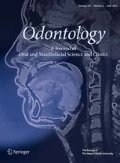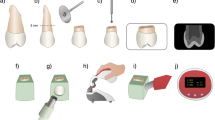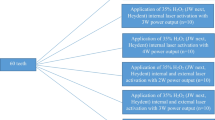Abstract
The aim of this in vitro study was to evaluate the colour stability of bleaching after light activation with halogen unit, laser, LED unit or chemical activation up to 3 months after treatment. Four groups of teeth (n = 20) were bleached with Opalescence Xtra Boost (38% hydrogen peroxide) using four different methods: activation with halogen, LED, laser or chemical activation only. All teeth were bleached in one session for four times (4 × 15 min) and the colour was evaluated using a spectrophotometer at the following time points: before bleaching, immediately after bleaching, 1 day, and 1 and 3 months after the end of bleaching. Between the tested time points, the teeth were stored in 0.9% NaCl solution. Additionally, the temperature increase in the pulp chamber was measured using a measuring sensor connected to a computer. Bleaching with the halogen unit showed the highest colour change. Halogen unit, laser and chemical activation resulted in whiter teeth after 1 and 3 months compared to the colour after the end of the bleaching procedure (p ≤ 0.05). Three months after the end of bleaching, the shade changes observed were—halogen: 7.1 > chemical activation: 6.2 > LED: 5.4 > laser: 5.2. Halogen showed the highest temperature increase (17.39°C ± 1.96) followed by laser (14.06°C ± 2.55) and LED (0.41°C ± 0.66) (p < 0.0001). Chemical activation did not affect the temperature in the pulp chamber. The use of light activation did not show any advantages compared to chemical bleaching. Although halogen unit showed the higher shade’s change, its use resulted also in the higher pulp temperature. According to the present findings, light activation of the bleaching agent seems not to be beneficial compared to bleaching without light activation, concerning the colour stability up to 3 months after bleaching and the pulp temperature caused during the bleaching procedure.
Similar content being viewed by others
References
Wiegand A, Drebenstedt S, Roos M, Magalhães AC, Attin T. 12-month color stability of enamel, dentine, and enamel–dentine samples after bleaching. Clin Oral Investig. 2008;12:303–10.
Giachetti L, Bertini F, Bambi C, Nieri M, Russo DS. A randomized clinical trial comparing at-home and in-office tooth whitening techniques: a nine-month follow-up. J Am Dent Assoc. 2010;141:1357–64.
Bizhang M, Chun YH, Damerau K, Singh P, Raab WH, Zimmer S. Comparative clinical study of the effectiveness of three different bleaching methods. Oper Dent. 2009;34:635–41.
Polydorou O, Hellwig E, Hahn P. The efficacy of three different in-office bleaching systems and their effect on enamel microhardness. Oper Dent. 2008;33:579–86.
Al Shethri S, Matis BA, Cochran MA, Zekonis R, Stropes M. A clinical evaluation of two in-office bleaching products. Oper Dent. 2003;28:488–95.
Hein DK, Ploeger BJ, Hartup JK, Wagstaff RS, Palmer TM, Hansen LD. In-office vital tooth bleaching—what do lights add? Compend Contin Educ Dent. 2003;24:340–52.
Reyto R. Laser tooth whitening. Dent Clin North Am. 1998;42:755–62.
Eldeniz AU, Usumez A, Usumez S, Ozturk N. Pulpal temperature rise during light-activated bleaching. J Biomed Mater Res B Appl Biomater. 2005;72:254–9.
Wetter NU, Barroso MC, Pelino JE. Dental bleaching efficacy with diode laser and LED irradiation: an in vitro study. Lasers Surg Med. 2004;35:254–8.
Calatayud JO, Calatayud CO, Zaccagnini AO, Box MJ. Clinical efficacy of a bleaching system based on hydrogen peroxide with or without light activation. Eur J Esthet Dent. 2010;5:216–24.
Buchalla W, Attin T. External bleaching therapy with activation by heat, light or laser—a systematic review. Dent Mater. 2007;23:586–96.
Weerakoon AT, Meyers IA, Symons AL, Walsh LJ. Pulpal heat changes with newly developed resin photopolymerisation systems. Aust Endod J. 2002;28:108–11.
Carrasco TG, Carrasco-Guerisoli LD, Fröner IC. In vitro study of the pulp chamber temperature rise during light-activated bleaching. J Appl Oral Sci. 2008;16:355–9.
Sulieman M, Rees JS, Addy M. Surface and pulp chamber temperature rises during tooth bleaching using a diode laser: a study in vitro. Br Dent J. 2006;200:631–4. discussion 619.
Hannig M, Bott B. In vitro pulp chamber temperature rise during composite resin polymerization with various light-curing sources. Dent Mater. 1999;15:275–81.
Sulieman M, Addy M, Rees JS. Surface and intra-pulpal temperature rises during tooth bleaching: an in vitro study. Br Dent J. 2005;199:37–40.
Lima DA, Aguiar FH, Liporoni PC, Munin E, Ambrosano GM, Lovadino JR. In vitro evaluation of the effectiveness of bleaching agents activated by different light sources. Int J Prosthodont. 2009;18:249–54.
Alomari Q, El Daraa E. A randomized clinical trial of in-office dental bleaching with or without light activation. J Contemp Dent Pract. 2010;11:17–24.
Sulieman M, Addy M, Rees JS. Development and evaluation of a method in vitro to study the effectiveness of tooth bleaching. J Dent. 2003;31:415–22.
Leonard RH Jr, Bentley C, Eagle JC, Garland GE, Knight MC, Phillips C. Nightguard vital bleaching: a long term study on efficacy, shade retention, side effects, and patients’ perceptions. J Esthet Restor Dent. 2001;13:357–69.
Auschill TM, Hellwig E, Schmidale S, Sculean A, Arweiler NB. Efficacy, side-effects and patients’ acceptance of different bleaching techniques (OTC, in-office, at-home). Oper Dent. 2005;30:156–63.
Sharif N, MacDonald E, Hughes J, Newcombe RG, Addy M. The chemical stain removal properties of “whitening” toothpaste products: studies in vitro. Br Dent J. 2000;188:620–4.
Watts A, Addy M. Tooth discolouration and staining: a review of the literature. Br Dent J. 2001;190:309–16.
Marson FC, Sensi LG, Vieira LC, Araújo E. Clinical evaluation of in-office dental bleaching treatments with and without the use of light-activation sources. Oper Dent. 2008;33:15–22.
Torres CR, Barcellos DC, Batista GR, Borges AB, Cassiano KV, Pucci CR. Assessment of the effectiveness of light-emitting diode and diode laser hybrid light sources to intensify dental bleaching treatment. Acta Odontol Scand. 2011;69:176–81.
Luk K, Tam L, Hubert M. Effect of light energy on peroxide tooth bleaching. J Am Dent Assoc. 2004;135:194–201.
Domínguez A, García JA, Costela A, Gómez C. Influence of the light source and bleaching gel on the efficacy of the tooth whitening process. Photomed Laser Surg. 2011;29:53–9.
Jones AH, Diaz-Arnold AM, Vargas MA, Cobb DS. Colorimetric assessment of laser and home bleaching techniques. J Esthet Dent. 1999;11:87–94.
Amengual Lorenzo J, Cabanes Gumbau G, Cervera Sánchez C, Forner Navarro L, Llena Puy MC. Clinical study of a halogen light-activated bleaching agent in nonvital teeth: case reports. Quintessence Int. 1996;27:383–8.
Scaminaci Russo D, Viano M, Bambi C, Nieri M, Giachetti L. Color stability of bleached teeth over time: an in vitro study. Eur J Esthet Dent. 2010;5:300–10.
Zantner C, Derdilopoulou F, Martus P, Kielbassa AM. Randomized clinical trial on the efficacy of a new bleaching lacquer for self-application. Oper Dent. 2006;31:308–16.
Greenwall L. Bleaching techniques in restorative dentisty. London: Martin Dunitz Ltd; 2001.
Heymann HO, Swift EJ Jr, Bayne SC, May KN Jr, Wilder AD Jr, Mann GB, Peterson CA. Clinical evaluation of two carbamide peroxide tooth-whitening agents. Compend Contin Educ Dent. 1998;19(359–62):364–6.
Goodis HE, White JM, Andrews J, Watanabe LG. Measurement of temperature generated by visible-light-cure lamps in an in vitro model. Dent Mater. 1989;5:230–4.
Zach L, Cohen G. Pulp response to externally applied heat. Oral Surg Oral Med Oral Pathol. 1965;19:515–30.
Lloyd A, Jaunberzins A, Dummer PM, Bryant S. Root-end cavity preparation using the MicroMega Sonic Retro-prep Tip. SEM analysis. Int Endod J. 1996;29:295–301.
Baldissara P, Catapano S, Scotti R. Clinical and histological evaluation of thermal injury thresholds in human teeth: a preliminary study. J Oral Rehabil. 1997;24:791–801.
Kreisler M, Al-Haj H, D’Hoedt B. Intrapulpal temperature changes during root surface irradiation with an 809-nm. GaAlAs laser. Oral Surg Oral Med Oral Pathol Oral Radiol Endod. 2002;93:730–5.
Conflict of interest
The authors declare that they have no conflict of interest.
Author information
Authors and Affiliations
Corresponding author
Rights and permissions
About this article
Cite this article
Hahn, P., Schondelmaier, N., Wolkewitz, M. et al. Efficacy of tooth bleaching with and without light activation and its effect on the pulp temperature: an in vitro study. Odontology 101, 67–74 (2013). https://doi.org/10.1007/s10266-012-0063-4
Received:
Accepted:
Published:
Issue Date:
DOI: https://doi.org/10.1007/s10266-012-0063-4




